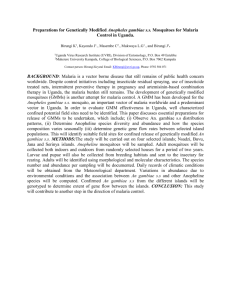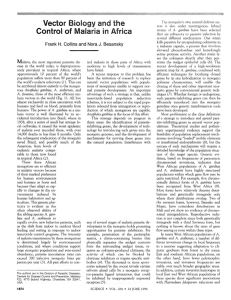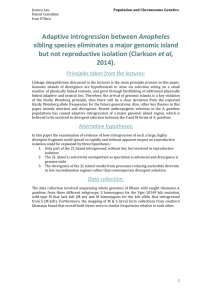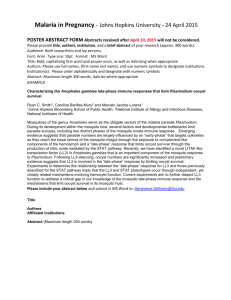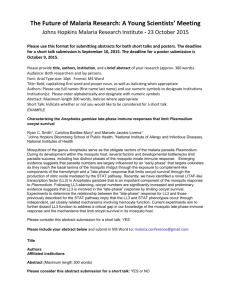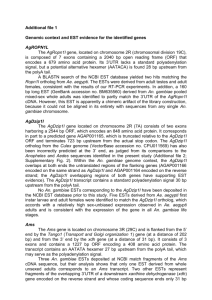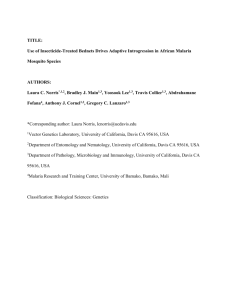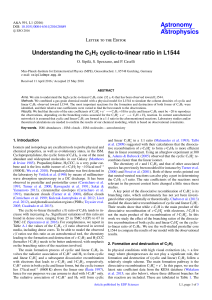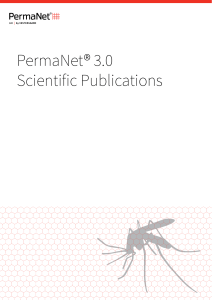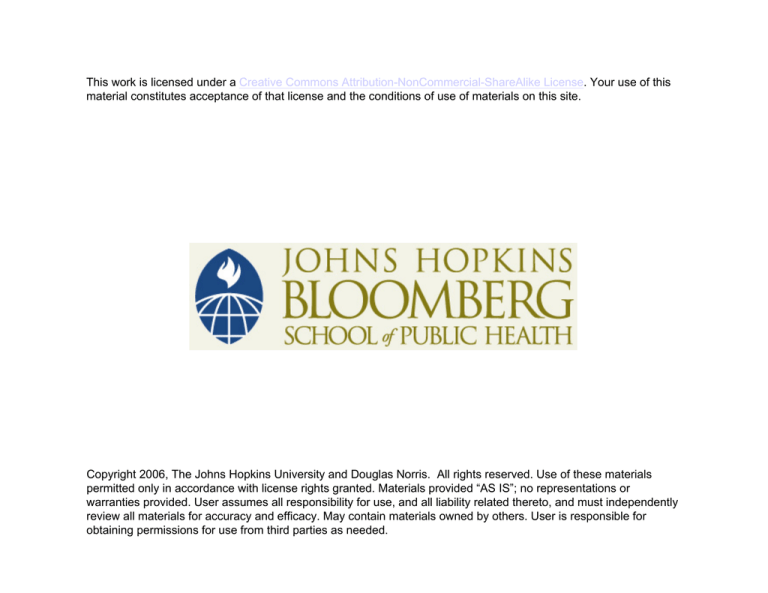
This work is licensed under a Creative Commons Attribution-NonCommercial-ShareAlike License. Your use of this
material constitutes acceptance of that license and the conditions of use of materials on this site.
Copyright 2006, The Johns Hopkins University and Douglas Norris. All rights reserved. Use of these materials
permitted only in accordance with license rights granted. Materials provided “AS IS”; no representations or
warranties provided. User assumes all responsibility for use, and all liability related thereto, and must independently
review all materials for accuracy and efficacy. May contain materials owned by others. User is responsible for
obtaining permissions for use from third parties as needed.
Insecticide Resistance and
Population Assessment in
Malaria Entomology
Douglas E. Norris, PhD
Structuring of An. gambiae
s.s. Populations
• Potential barriers to gene flow
– Premating - mixed swarms
– Postmating - hybrid survival
- Infertility
– Polyandry - sperm competition
Levels of Speciation in
Anopheles gambiae s.l. Complex
• Anopheles gambiae s.l. (1956)
– An. arabiensis – more zoophilic and exophilic
– An. gambiae s.s. - ***
• Bamako, Mopti, Savanna
• Forest, Bissau
– An. melas – coastal West Africa
– An. merus – coastal East Africa
– An. bwambae – limited distribution
– An. quadriannulatus A and B – zoophilic nonvector
Anopheles gambiae (s.l.) Complex
An. arabiensis
An. bwambe
An. gambiae s.s.
Mopti
Mopti (M)
molecular
form
An. melas
Bamako
Savanna
Savanna (S)
molecular form
An. merus
An. annulatus A & B
Forest
Bissau
Complexities of Insecticide
Resistance
• Metabolic Detoxification
– Enzyme metabolism and sequestration of
insecticides (Esterases, cytochrome P-450s)
– Transcriptional regulation (GSTs)
• Esterases in Culex
• Monooxygenases in a variety of insects
• Target-site Mutation Derived Resistance
– Mutations aimed at insecticide target site
Metabolic Detoxification
• Very important to mosquito control
– Difficult to assess
– Many potential enzymes involved
– Mechanisms poorly understood (mutations ?)
• Detecting resistance
– WHO bottle assays
– Biochemical tests (color-metric assays)
– Molecular assays (PCR-based, hybridization
assays)
kdr Resistance in An.
gambiae
• Cross resistance to pyrethroids and
DDT
• Mendelian inheritance; resistant (RR),
susceptible (SS), intermediate (RS)
• Single point mutation conferring amino
acid change in the voltage-gated
sodium channel
(Martinez-Torres et al. 1998)
kdr Resistance in An. gambiae and
others (cont.)
• Single point mutation changing leucine TTA to
phenylalanine TTT – confers high levels of
resistance
• Physically mapped to 2L 20C – in range of
resistance associated QTL, but unclear if GST
related
• An. gambiae from Côte d’Ivoire and Burkino
Faso
• Same mutation in Musca domestica, Blatella
germanica
kdr Resistance in An. gambiae
and Others (cont.)
• Single point mutation changing leucine
TTA to serine TCA – confers low
levels of resistance
• An. gambiae from Kenya
• Culex pipiens from China
Distribution of kdr Resistance
• In parts of West Africa widely distributed An.
gambiae s.s. Savanna form (Chandre et al.
1999)
• As of 2000 only found in An. gambiae s.s.
Mopti form in Benin (Weill et al. 2000)
• kdr stably transferred from Savanna to Mopti
in laboratory
• Currently found in M and S forms from
multiple sources
• In Bioko only found in M form, not S
Transgenic Replacement
Strategy
“The goal is to replace a wild mosquito population,
efficient at transmitting malaria parasites, with a
population that is virtually identical in all respects
except for its ability to transmit the parasites.”
- Frank Collins & Anthony James, 1996
Requirements for Strategy
Implementation
• Discovery of genes that block Plasmodium
development in the mosquito but do not
adversely affect fitness
• Development of techniques to manipulate the
mosquito genome
• Development of a genetic drive mechanism
• Elucidation of the ecology and genetic
structuring of An. gambiae
Getting Refractory Genes or Alleles
into Mosquitoes (Transformation)
• Mostly Class II transposable elements
(Hermes, mariner, Minos)
• Insert into DNA by recognition of
inverted repeat (ITR) sequence at the
termini of the element, excise target
DNA and integrate element
• Exogenous ITRs are engineered into
system to control insertion
Where Should
Integration/Expression Occur
• Integration of exogenous gene so that
expression (when, where and how
much) is controlled by an endogenous
promoter
• Development has targeted tissues
where significant pathogen / mosquito
interaction occurs
Where Should
Integration/Expression Occur II
• Targeted tissues: midgut, salivary
glands and fat body
• Therefore target promoters of genes
with specific expression in these tissues
(i.e. Apyrase in adult salivary glands)
Refractory Genes
•
•
•
•
Midgut mis-recognition
Melanotic encapusulation
Intracellular lysis
Large variation in refractory phenotype
(and transcriptional response to
infection) confirm that there is a
physiological cost to parasite infections
in the mosquito
Antiparasite Effector Molecules
• Single-chain antibodies (i.e. made to
CSP) – worked following injection
• Theory proven by flavivirus RNAi in
mosquitoes (Ae. Aegypti)
• Inhibition of midgut penetration
• Melanization of oocysts
Molecular Linked Phenotypes
of Interest
• Vector competence for Plasmodium
• Stability/movement of refractory
gene in transgenic/field populations
– Drive mechanisms
The Basics
•
•
•
•
Mendelian genetics
Phenotype vs. Genotype
Homology vs. Analogy
Hardy-Weinberg principle (1908)
– provides a method for predicting genotype
frequencies from observed allele
frequencies
Hardy-Weinberg Assumptions
1.
2.
3.
4.
5.
6.
7.
8.
Diploid organism
Sexual reproduction
Nonoverlapping generations
Random mating
Population is very large
Migration is negligible
Mutation is negligible
Gene(s) under consideration are not
affected by natural selection
Deriving the Hardy-Weinberg Equation
Eggs
Sperm
Allele Frequency
A
a
Allele
p
q
Frequency
A
p
AA
p2
Aa
pq
a
q
Aa
pq
Aa
q2
1 = p2 + 2pq + q2 = freq(AA) + freq(Aa) + freq(aa)
Evaluating for H-W Equilibrium
• Usually done using a goodness-of-fit
test by means of a chi-squared value
(X2)
• X2 = Σ (observed number – expected
number)2/(expected number)
Heterozygosity (H)
• The frequency of heterozygous loci per
individual or heterozygous individuals per
locus
• H is relatively stable within a population for a
defined set of markers independent of sample
size (marker dependent)
• Often used to identify restricted gene flow
among populations
Wright’s F-statistics
• (1 – FIT) = (1 – FST)(1 – FIS)
• FIS – correlation between homologous alleles
within individuals with reference to a local
population
• FIT – correlation between homologous alleles
with reference to the total population
• FST – interpreted as the variance component
• FI = 1 – (Hobs/Hexp)
FIS
FIS
FST
FIS
FST
FST
FIS
FST
FIS
Migration
• Nm – is the migration frequency or more
importantly the frequency of matings
between populations due to migration…
• In theory as little as 1 mating between
populations/generation is enough to
homogenize populations
Microsatellites
DNA extraction and PCR amplify
CAAGGCGTTGACAGTGTGTGTGTGTCTTATCACTGCGTC
GTTCCGCAACTGTCACACACACACAGAATAGTGACGCAG
55
160
165
06•BD - 79
170
175
180
185
190
195
200
205
210
215
220
6 Blue
3000
2000
1000
16
118
120
122
124
126
128
130
132
134
136
138
140
142
09•M16 -…8/242/811 9 Green
600
400
200
Mendelian Codominant Inheritance
CAAGGCGTTGACAGTGTGTGTGTGTGTGTGTGTCTTATCACTGCGTC
GTTCCGCAACTGTCACACACACACACACACACAGAATAGTGACGCAG
CAAGGCGTTGACAGTGTGTGTGTGTGTGTCTTATCACTGCGTC
GTTCCGCAACTGTCACACACACACACACAGAATAGTGACGCAG
CAAGGCGTTGACAGTGTGTGTGTGTCTTATCACTGCGTC
GTTCCGCAACTGTCACACACACACAGAATAGTGACGCAG
A
B
C
C
B
A
So, What About Bednets?
• Rumor is that bednets may select for
resistant populations…
• Increased levels of permethrin tolerance
noted in Kenyan An. gambiae due to
selection for increased oxidase and
esterase levels (Vulule et al. 1999)
• Increased levels of insecticide [DDT]
resistance noted elsewhere in
association with bednets… agricultural
applications?
Bednets and kdr Resistance
• No kdr detected in Western Kenya despite
extensive use of impregnated bednets
(Ranson et al. 2000)
• Despite kdr, impregnated bednets may still
provide protection (Chandre et al. 2000)
• kdr lowers sensitivity to ‘killing’ activity and
also to irritant/repellent effects
• Therefore mosquitoes succumb to prolonged
contact (3-18 times longer)
The Future of Insecticide
Resistance Research
• Will continue to utilize cutting-edge
technologies for detection and
understanding (Oakeshott et al. 2003)
– Comparative genomics for finding genes
– Microarrays for detecting mutations in gene
families (i.e. P-450s) – Detox Chip
– Mapping of genes / traits (QTLs, positional
cloning)
• Selective sweeps – no chance for
recombination of resistance / susceptibility

